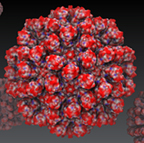As a part of the 2025 Beckman Institute Open House (BIOH), the Theoretical and Computational Biophysics Group (TCBG) offered an exciting and immersive glimpse into the molecular world of modern biology through cutting-edge virtual reality (VR) experiences. As developers of the widely used molecular simulation tools NAMD and VMD, TCBG takes pride in making science accessible to and inspiring for the broader community. At this year's BIOH, visitors had the opportunity to fly through molecular structures, manipulate DNA interactively, and step inside protein complexes that power living cells, all in VR. A standout attraction was the Minecraft-style virtual cell exploration, where guests navigated through blocky but biologically accurate cellular environments generated from real 3D microscopy data. The event drew curious minds of all ages, from young aspiring students to seasoned researchers, showcasing TCBG's ongoing mission to bridge science, technology, and public engagement.
The Future of Biomolecular Modeling
VMD Illuminated
Announcements
Seminars
Remembering Klaus Schulten
Recent Publications All Publications
- Cholesterol-targeting Wnt-β-catenin signaling inhibitors for colorectal cancer. Nat. Chem. Biol., 2025.
- Dissecting Large-Scale Structural Transitions in Membrane Transporters Using Advanced Simulation Technologies. J. Phys. Chem. B, 129:3703-3719. 2025.
- Modeling Diffusive Motion of Ferredoxin and Plastocyanin on the PSI Domain of Procholorococcus marinus MIT9313. J. Phys. Chem. B, 129:52-70. 2025.
- Membrane-bound model of the ternary complex between factor VIIa/tissue factor and factor X. Blood Adv., 9:729-740. 2024.
- Protein-Lipid Interactions in Priming the Bacterial Translocon. Membranes, 14:249. 2024.
- Atomistic characterization of β2-glycoprotein I domain V interaction with anionic membranes. Journal of Thrombosis and Haemostasis, 22:3277-3289. 2024.
- Modulation of ABCG2 Transporter Activity by Ko143 Derivatives. ACS Chem. Biol., 19:2304-2313. 2024.
Highly Cited
Click here for other highly cited papers







